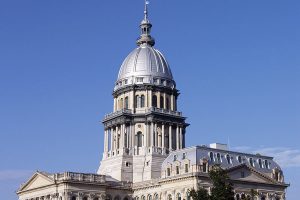Family First Prevention Services Act: What you need to know
Publisher: ICOY Staff

Preparing for FFPSA Implementation
The Family First Preservation Services Act (FFPSA) that passed Congress last year represents a significant change from how the Federal government will fund child welfare services through Title IV-E going forward. While some aspects of the legislation have been implemented already, most major changes will not take effect until later this year.
In Illinois, we have applied for an extension of up to two years before fully implementing the FFPSA; however, the state has been working on a planning effort to try to make the October 1, 2019 initial deadline. Part of our challenge is that our state is currently under a Title IV-E waiver, which expires at the end of September. The loss of this waiver will mean the loss of more than $36 million from our state child welfare budget.
ICOY has reached out to Senators Durbin and Duckworth, asking them to support an effort to extend the Federal waivers for up to two years, to coincide with the extension on the FFPSA implementation.
The Facts about the Family First Prevention Services Act of 2018:
* Allows Title IV-E funding to be spent on services to prevent children and youth who are “candidates for foster care” from coming into care, and allow them to remain with their families.
* Services can be provided for up to 12 months.
* States must develop a written, trauma-informed plan to provide evidence-based services.
* The Federal government will reimburse states for 50% of eligible prevention services.
Eligible Populations for Prevention Services
* “Candidates for foster care” must be defined by each state; the Federal government will not be supplying a legal definition for this term
* Pregnant or parenting foster youth are also eligible
* Children under the guardianship of a kin caregiver are also eligible
Eligible Prevention Services
* In-home parent skill-based programs
* Mental health services
* Substance abuse prevention and treatment services
Services Must
* Be included in the state’s written plan
* Have a manual
* Show a clear benefit
* Fall on the continuum of evidence-based services
Evidence-Based Services
* Promising Practice = Created from an independently reviewed study that uses a control group and shows statistically significant results
* Supported Practice = A random control trial or rigorous quasi-experimental design that shows sustained results for at least 6 months post-treatment
* Well-Supported Practice = At least two random control trials or rigorous quasi-experimental design studies that show success beyond a year after treatment
Challenges For EBP Implementation
* At least 50% of the expenditures eligible for Federal reimbursement must be well-supported practices
* Contractor selected to establish a national database/clearinghouse of “approved” evidence-based services; 11 services are currently being reviewed
* Timeframes and funding to grow this list
* Opportunities for innovation and experimentation going forward
Reduces Federal Reimbursement for Congregate Care to 14 Days
* Foster homes of more than 6 children
* Child care institutions of 25 children or fewer
* Exceptions are for:
– Juvenile justice settings
– Qualified Residential Treatment Programs
– Prenatal, postpartum, or parenting support for young mothers
– Supervised independent living programs for youth 18 and older
– Youth who are victims or at risk of human trafficking
Qualified Residential Treatment Program (QRTP)
* Accredited by CARF, COA, or the Joint Commission
* Uses a trauma-informed treatment model
* Staffed by registered or licensed nursing staff, onsite according to the treatment model, and available 24/7
* Includes family members in the treatment and documents family involvement
* Provides 6 months post-discharge support
Use of a QRTP
* Independent assessment* within 30 days of placement to determine whether placement is appropriate with no exceptions (no Federal funds will be disbursed if this requirement is not met)
* Court review at 60 days
* Head of state child welfare agency must submit to HHS approval for continued placement after 12 consecutive months or 18 nonconsecutive months
* Assessor must not be an employee of the Title IV-E agency or the QRTP, although this can be waived.
Other Considerations on Congregate Care
* Use of licensed residential family-based treatment facility for substance abuse treatment
* States must develop a plan to prevent increases in the juvenile justice population
* States must train judges and court staff on the appropriate use of QRTPs and need to place youth in foster families
* By 2020, the U.S. DHHS will conduct an assessment of best practices
* States have flexibility to further define exceptions to congregate care limitations, such as approving students living in a dormitory at college as a supervised independent living arrangement for youth over 18
* ACF is also not further defining high-quality residential programs for youth who are victims of or at risk of human trafficking
* States can delay implementation of the congregate care rules for up to two years, but they also must delay claiming on prevention services during that same time period
* No Federal funds may be used for non-approved congregate care settings beginning in the 3rd week (day 15)
Expansion of the Regional Partnership Grants Program
* Regional Partnership Grants are targeted to improve the safety, permanency, and wellbeing of children in substance-abuse affected families, and to prevent or reduce their involvement in foster care
* Extends the RPG program for another 5 years
* Allows RPG funding to be used on a statewide basis
* Allows organizations other than the state child welfare agency to apply
* https://ncsacw.samhsa.gov/technical/rpg.aspx
Other Opportunities & Considerations
* One Time, $8 Million Competitive Grant to Recruit Foster Families
* Extend Chaffee Foster Care Independence Programs to Age 23
– If the state has extended services to age 23
– Education and training vouchers may go to age 26
– No more than five years total
Resources
Children’s Bureau Information Memorandum April 12, 2018
Children’s Bureau Program Instruction May 31, 2018
Children’s Bureau Program Instruction July 9, 2018
National Conference of State Legislators
Programs for Review by the FFPSA Clearinghouse
CARF International FFPSA Microsite
Casey Family Programs FFPSA Resources
Executive Summary: Interventions with Special Relevance for the Family First Prevention Services Act
Timeline for Implementation: Several Deadlines Have Already Occurred
* October 1, 2018 – Criminal history and child abuse and neglect background checks on any adult working in a child care institution
* October 1, 2018 – States must document steps taken to track and prevent child maltreatment fatalities
State Licensing Standards Align with HHS Model
* April 1, 2019 – States must submit a plan showing alignment with Feds
The Crucial Decision Every State Must Make
* Implement FFPSA beginning on October 1, 2019 to claim new prevention funding and comply with congregate care restrictions OR
* Delay implementation of FFPSA for up to two years, with no funding for prevention services
* All IV-E Waivers are current set to sunset prior to October 1, 2019
* Potential for Federal Delay on Waiver Expiration
* https://www.childrensdefense.org/wp-content/uploads/2018/08/ffpsa-implementation.pdf
ICOY in the News






